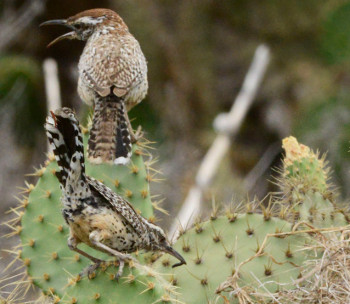What's to eat? That’s the first question any teenager asks when walking in the door. Well, teens aren’t the only ones. Consider cactus wren chicks, for instance. They are hungry!

In a mere three weeks, these young birds grow from naked closed-eye creatures that came out of eggs less than an inch across to fully feathered birds at least as big as the adults. That takes food. Lots of it.
But what is it that they eat? The answer is lots of high-protein animal matter, mostly insects; really anything small enough to tuck into a chick’s mouth seems to do. The adults know their patch, not only the other residents—birds, rodents, herps--which share their habitat, but also the insects that make up so much of the diversity of life in and around the cactuses containing the nest. In truth, bugs will make up much of the growing youngsters’ diet.
I’ve been watching a pair of nesting wrens recently, taking photos of what the adults bring in to their young. The variety is amazing. Most of what I’ve seen is hard to identify, for instance, caterpillars in various states of squish and things like that. But what I have been able to pick out is highly varied: one of our common drone flies (Eristalis sp.), a leaf-footed bug (Narnia sp.), many moths and lots of bees (Diadasia sp., honey bees and others).
The number of bees surprised me. It’s not that they are uncommon in the habitat, but that I had assumed the bees’ sting would be a major deterrent. Not all bee stings are the same, but to a nestling, I would have thought any sting would be fatal. Yet the adults brought bees in by the score. Those prickly pear patches do look barren to outsiders like me, but when it comes to living off them, cactus wrens know exactly what’s to eat and where to find it.


